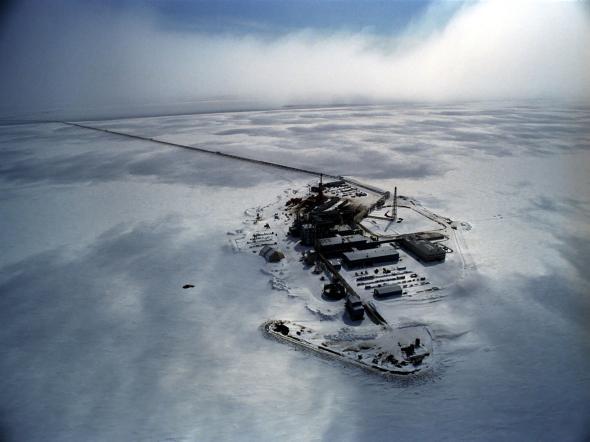Americans tends to look down on most of the world’s petrol states: countries that depend disproportionately on the extraction of oil and gas for industry, tax revenue, and international legitimacy. With the rare exception of Norway, where oil revenues generated from prodigious offshore oil fields have been channeled into a massive, publicly owned mutual fund, the resource bounty in most petrol states has led to environmental, social, and political stupefaction and degradation. Think of the oppressive and lazy Persian Gulf oil monarchies, Nigeria’s widespread corruption and its polluted and violent Delta region, the urban hellhole of Caracas, and the more general disaster that is Venezuela.
But we forget that portions of the U.S., including some of its remote, least-visited, and least-populated areas, have effectively become petrol states. And in general, they are using their oil wealth in a more restrained manner. Earlier this year, I reported on how North Dakota is deploying the gusher of oil revenues spouting from the Bakken Shale formation in very North Dakota ways. In some respects, Alaska is even more conservative about husbanding its collective oil wealth.
Last week, I visited the 49th state as an unabashed, agape tourist: dog-sledding atop the Mendenhall Glacier, viewing humpback whales at Icy Point Strait. The only large-scale assemblages of locals I encountered were in Juneau on primary day waving signs for and against ballot measure No. 1, a proposal that would have repealed tax cuts recently offered to oil drillers. (It narrowly went down to defeat.)
Oil production, which takes place far from Alaska’s population and tourist centers, is of unique interest to the state’s 735,000 residents. Far beyond providing substantial employment, oil production in Alaska—to a degree unparalleled in any other state—helps support quality of life and alleviates some of the hardships of living in the north.
Most people who follow politics are familiar with one of the ways oil wealth is shared in Alaska. As was pointed out frequently during Sarah Palin’s appearance on the national scene, Alaska is in some ways a socialist haven. For the last several decades, oil pumped out of Prudhoe Bay and elsewhere in the state has been regarded as a state resource. The Alaska Permanent Fund was founded in 1976 as a basin to hold “at least 25 percent of all mineral lease rentals, royalties, royalty sales proceeds, federal mineral revenue-sharing payments and bonuses received by the state.” Its beneficiaries, according to the state constitution, were to be “Alaska and all present and future generations of Alaskans.”
Each year, about one-quarter of the oil production tax flows into the fund’s coffers. And even though production in Alaska has fallen over time, the elevated price of oil has kept the volume of revenues high. In 2013, some $840 million flowed into the fund.
Thanks to constant inflows and buoyant markets, the fund has now grown to a very substantial size: $51.6 billion in assets as of mid-August. By law, the principal can’t be touched. A large chunk of the substantial income it produces each year ($2.9 billion last fiscal year) goes back into the fund to compensate for inflation. Every year, about 20 percent of the fund’s earnings are paid out in the form of a taxable dividend to qualified state residents. The dividend is calculated as a small portion of the fund’s average income over the previous five years. Last year, some $576.4 million was available for dividends, amounting to $900 for each of the 640,249 eligible state residents. (Here are the eligibility requirements.) Because oil production has declined, the annual dividend is much smaller than it used to be—in 2000, it was $1,963. Nonetheless, since its inception, the fund has paid out $21 billion.
The dividend functions as a reward—or bribe, depending on your perspective—for living in Alaska. Even at its reduced level, it provides a significant fillip to Alaska’s income. The state’s household per capita income is $69,917, well above the $53,046 figure for the U.S. Only 9.6 percent of Alaskans have income below the poverty line, compared with 14.9 percent for the nation as a whole.
But there’s a more significant, less obvious way in which oil wealth helps support the financial well-being of Alaska. Most people probably don’t know that the state imposes neither a sales tax nor an income tax on its residents. Instead, it relies almost exclusively on taxes on energy and mineral production and extraction to help fund its budget. (Data on Alaska’s tax revenues can be seen here and here.) In fiscal 2013, the main levy—the oil and gas production tax—brought in $3.975 billion, or 78.5 percent of the total taxes Alaska collected. But there’s more. Corporate income taxes on oil and gas companies brought in another $541.4 million, or 10.7 percent of the total collected, while property taxes on oil and gas facilities accounted for another $99.3 million, or 2 percent. All in, more than 91 percent of the state’s tax revenues derive from the oil and gas industry. That totals about $4.615 billion, or about $6,300 for each person living in Alaska. That’s a very large amount of taxes that individuals living in Alaska don’t have to provide.
Because they have been used so sparingly, Alaska’s oil funds function as a form of insurance. If oil production falters, or if the broader economy takes a big hit, or if a natural disaster strikes, Alaska can tap the giant pool of cash in the permanent fund—about $68,000 per resident. In the meantime, while there are plenty of annoyances of living in Alaska, income and sales taxes won’t be among them.
